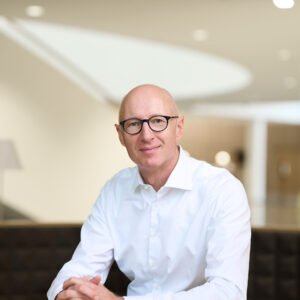Obesity, by and large, is not a problem in the land of the Little Mermaid and midcentury modern design. In Denmark’s capital, Copenhagen, bicycles outnumber cars five to one, people swim laps in Nyhavn Harbor well into September, and—despite a clear fondness for pastries, hot dogs, and alcoholic beverages—apparently few people put on weight. The country has one of the lowest obesity rates in Europe, though at 18.4% in 2021, it has risen considerably from 6.1% in 1987.
The rest of the world, too, is wrestling with rising obesity. In the United States, 42% of adults are considered obese, and nearly three-quarters qualify as obese or overweight. The World Obesity Federation predicts that 51% of the global population will be overweight or obese by 2035.
The solution to this epidemic may very well sit a 45-minute bike ride from downtown Copenhagen, at the corporate offices of the Danish pharmaceutical company Novo Nordisk—now known to the world as the maker of Ozempic and Wegovy.
A light-filled cylinder designed by Henning Larsen, Novo Nordisk’s headquarters pays architectural tribute to the spiral coil of the insulin molecule—the company’s traditional source of revenue. Today, a better shape would be the sickle-shaped molecule of a peptide called semaglutide, which is used in a type of drug known as a GLP-1 agonist. These medications help regulate blood sugar in people with type 2 diabetes and, by suppressing appetite, help users shed an average 15% of their body weight over 64 weeks, an amount comparable to gastric-bypass surgery.
Today, Novo sells semaglutide in three forms: as Ozempic, a once-weekly injectable for treating type 2 diabetes, and prescribed off-label for weight loss; Wegovy, a higher-dose injectable approved for weight loss; and Rybelsus, an oral type 2 diabetes drug. (The company expects to complete trials of an oral version of Wegovy by the middle of next year.) Miraculous, controversial, and expensive, the drugs have ignited debates worldwide about everything from access and pricing to body image and the nature of obesity—and unleashed a frenzy.

“Had we predicted this, we would have prepared differently,” says Novo Nordisk CEO Lars Fruergaard Jørgensen, with typical Danish understatement. Less than one year after hitting the market in Denmark, more than 1% of the population was taking it, most paying about $340 a month. But Denmark has a population of just 6 million. It’s the U.S. math that matters. Here, where Wegovy costs about $1,300 a month and Ozempic $1,000, about 1.7% of American adults who saw a doctor last year were prescribed one of Novo Nordisk’s semaglutide drugs.
Driven by the U.S., Wegovy sales hit $1.38 billion in the third quarter of 2023, up more than eightfold from a year ago, and Ozempic sales rose about 59% to nearly $9.4 billion. Together, the drugs accounted for more than half of Novo’s revenue. The company is now forecasting that 2023 revenue could reach as high as $33 billion, a 39% increase from 2022. In August, the drugmaker overtook luxury goods conglomerate LVMH as Europe’s most valuable listed company. At $430 billion, its market capitalization exceeds Denmark’s entire gross domestic product. “This new generation of GLP-1 products have significantly added to market growth,” says Jørgensen, “but also grown a more aggressive market share” for the company. Using its weight-loss winnings, Novo is now advancing new uses for GLP-1 drugs—including for heart conditions and chronic kidney disease—that could be even more lucrative.

Hype around the medications—and the slimmed-down society that they might usher in—is radiating across the economy. In October, Walmart warned that GLP-1 medications were causing shoppers to pare back on groceries. This revelation created a ripple effect, deflating shares of food giants like Krispy Kreme, Nestlé, and Mondelez International. Morgan Stanley has estimated that 7% of the U.S. population, or 24 million people, will be taking hunger-suppressing weight-loss drugs by 2035 and cutting their daily calorie consumption by as much as 30%. Other analysts are anticipating that lighter passengers could save airlines significant money on fuel costs.
The drugs are often called runaway successes. And they are, so much so that Novo Nordisk has had trouble keeping up with demand, leaving some patients with diabetes—Ozempic’s traditional base—scrambling. But behind the scenes, Novo has spent more than 15 years developing these shockingly effective drugs, and at least a half dozen years engineering their widely successful public rollout, especially in the U.S.
At home in Denmark, where the company employs some 21,000 people, Novo Nordisk has a reputation as an enlightened corporation. Through its foundation, it distributed grants worth about $1 billion to scientific and cultural initiatives in 2022 alone. That largesse at home is made possible by its laser-focused commercial approach, which hinges on tapping into the vanity of Americans and finding the fat in the lucrative U.S. healthcare system.
When Jimmy Kimmel hosted the 2023 Academy Awards in March, he opened with a zinger: “When I look around at this room I can’t help but wonder, ‘Is Ozempic right for me?'”
The joke, aimed at the ranks of suddenly svelte stars in the room, was a nod to Novo’s increasingly ubiquitous ads. Since Ozempic’s launch as a type 2 diabetes drug in the U.S. in early 2018, the company has spent hundreds of millions of dollars on direct-to-consumer marketing, including TV ads. In 2022, it put $180 million toward Ozempic ads, including an estimated $157 million on TV spots in the U.S., according to ad measurement firm iSpot.tv. (The U.S. and New Zealand are the only countries that allow direct-to-consumer prescription drug advertising.) Novo spent another $120 million on ads for Ozempic in the first six months of this year, and $20 million to promote Wegovy, according to analytics firm MediaRadar.
By spring 2023, it was impossible to avoid the earworm jingle of the “Oh, oh, oh, Ozempic” ads (set to the 1970s pop song “Magic” by Pilot). Those commercials not only noted the drug’s benefits for blood glucose and cardiovascular concerns, they also pointedly talked the average 12 pounds that patients lost in clinical trials. Among the elite crowd in Los Angeles’s Dolby Theater, it was already common knowledge that Ozempic wasn’t just for diabetes.
It wasn’t just Hollywood driving demand for the skinny shot. By late 2022, the term “Ozempic” had more than 300 million views on TikTok. Everyone from suburban moms to Elon Musk was hopping on social media to share their (mostly) positive experiences with GLP-1 agonists. Ads for online pharmacies offering semaglutide proliferated on city subways, and med spas touted their access to Ozempic, openly flouting restrictions on marketing off-label uses of medications. Insurance companies scrambled to update their coverage. And Novo Nordisk, facing supply chain issues, struggled to keep up with the demand that it had created.

It was a scenario impossible to imagine when Novo Nordisk was created, in 1989, with the merger of the Danish pharma companies Nordisk Insulinlaboratorium and Novo Therapeutisk Laboratorium, which since the 1920s had produced medicines based on insulin, a peptide hormone that regulates blood sugar levels. Today, the company sells roughly half of all insulin globally, by value, a business that brought in about $7.6 billion in 2022.
By January 2017, though, when Jørgensen took over as CEO, the company’s insulin business had plateaued. “We had a situation where growth was low,” he recalls. The U.S. has traditionally accounted for nearly half of the insulin market, but competition and increasingly large discounts negotiated with state Medicaid programs and pharmacy distributors were driving down prices. Luckily, Jørgensen had a new class of drugs to rally the company around: GLP-1 agonists, which mimic the action of a gut hormone called glucagon-like peptide 1 to stabilize blood sugar.
“You can say we have been on the GLP-1 market for some 15 years,” he says. Novo first started research into GLP-1 drugs to treat type 2 diabetes in the early 1980s. But the work languished until Novo scientist Lotte Bjerre Knudsen created an analog of GLP-1 called liraglutide. Marketed as a once-daily injectable called Victoza, liraglutide was approved by the FDA in 2010 for diabetes, and in 2014, as a weight-loss drug called Saxenda.
Most patients taking Victoza lost less than 10% of their body weight. “That was the best that was around,” says Jørgensen. “But it still wasn’t something that was widely used.” Novo’s next molecule—semaglutide—crossed a threshold, improving diabetes control and causing an average weight loss of 15%. That “was a game changer,” he says.
Novo started reporting clinical data from trials of semaglutide—including its weight-loss “side effect”—in late 2016. By the time the FDA approved Ozempic in December 2017 for use for type 2 diabetes, “patients were mobilized,” Jørgensen says. “For the first time, we had a product where patients went to the physician to ask for the medicine, and [then] the physician asked us about it.”
Patients may have been seeking out Novo’s drugs, but the company was helping them along, especially in North America, a territory responsible for nearly half of its revenues last year. With a population of nearly $340 million people and the highest drug prices in the world, the U.S. is a proverbial cash cow for drugmakers. And for a company selling drugs for diabetes and obesity, the U.S. really delivers, with a high prevalence of both. The Federal Trade Commission estimates that U.S. consumers spend $33 billion per year trying to either lose weight or prevent weight gain.
Capturing this market was a yearslong effort. Doug Langa, Novo’s head of North America operations, says that his division underwent a profound transformation in 2017, as Ozempic was nearing FDA approval. “We were like a Formula One racing car in a pit stop,” he recalls. “We were going to take off our insulin tires and put on our GLP-1 tires, which meant taking a lot of representatives and marketing spend and moving it into GLP-1.”
“We knew that we had something special with Ozempic,“ recalls Dave Moore, Novo’s executive vice president of corporate development, who presided over the North America launch. “The countless clinical trials, tens of thousands of patients, were showing this was a unique opportunity. Long-term, Ozempic was so important for the organization because we knew that ongoing R&D was going to lead to other opportunities and other patients.”
Moore says that, at the time, it was a challenge to get doctors “to think about obesity as a serious chronic disease” and as a gateway to other complications and conditions. Educating medical professionals had long been a focus in the marketing of the company’s diabetes products, “so it was a natural changeover for obesity as well,” he says.
Novo’s “education” budget has been generous. Between 2013 and 2022, according to a recent Reuters investigation, Novo spent at least $25.8 million on U.S. doctors, related just to its weight-loss drugs, Wegovy and Saxenda. That includes speaking and consulting fees, food and beverage costs, and travel and lodging expenses. According to records from the Centers for Medicare and Medicaid Services, in 2022 alone, Novo spent $11 million on meals and travel for U.S. doctors to promote its GLP-1 drugs, buying some 457,000 meals and funding trips to London, Paris, Orlando, and Honolulu. By comparison, Eli Lilly spent roughly $3.5 million in 2021 on meals and travel to promote its GLP-1 drugs, Mounjaro and Trulicity.
Wining and dining doctors is generally legal, although conversations between pharma sales reps and doctors are governed by a code of ethics that limits, among other things, sharing information about future or off-label indications—such as, say, using Ozempic for weight loss. But money and meals make a difference, even if doctors need to connect the dots themselves. An analysis by ProPublica from 2016 found that doctors who received industry payments, or even just a meal, prescribed higher-priced brand-name drugs at a much higher rate than their peers, versus cheaper generics.
Novo Nordisk has skirted ethical lines in the past. In 2017, the company settled a Department of Justice probe into a “white coat marketing scheme” that allegedly included paybacks to doctors and disguising salespeople as medical educators in the promotion of three diabetes drugs. In June 2011, the company paid $25 million to settle a lawsuit over alleged improper promotion of an anti-clotting medicine for off-label indications. It also reached a $1.725 million deal with the U.S. Attorney in Brooklyn addressing allegations that sales reps in several states paid pharmacists to recommend two of its diabetes treatments. (Novo Nordisk did not admit wrongdoing in either settlement.) This January, the Physicians Committee, a nonprofit public health advocacy organization, filed a complaint with the FDA arguing that a 13-minute 60 Minutes story about Wegovy was so one-sided—and Novo Nordisk such a big advertiser—that the “news” spot amounted to an ad, violating the FDA’s requirement that ads disclose drug risks.
There’s also the significant issue of off-label prescribing. Novo has followed the law in not marketing Ozempic exclusively for weight loss. But off-label prescriptions have both fueled the company’s rocket-ship revenue growth and led to shortages for diabetes patients. (Wegovy is approved for weight loss, but production of the drug won’t catch up to demand for many months.) Data on prescribing trends in 50 major U.S. cities, analyzed by Trilliant Health for CNN, shows off-label prescribing of Ozempic soaring nationwide. In some cities—including Boston and Hartford, Connecticut—about half of Ozempic prescriptions in the first quarter of 2023 went to people who did not have a history of diabetes.
“Don’t get me started on Ozempic,” says an ob-gyn in the San Francisco Bay Area. “Our patients are offered it if they meet a few clinical criteria for weight loss, and you can manipulate the system so you [qualify for insurance] with little or no copay.”
There’s nothing illegal or unethical about a doctor prescribing an approved medication for something outside its indicated use, if it’s for a good medical reason. But Ozempic prescribing has been pushing the limits. “There are plenty of people that are using this like a fad diet,” says Scott Kahan, an obesity medicine specialist at the National Center for Weight and Wellness in Washington, D.C. “They’re losing 40 pounds in two, three months, and they’re making themselves sick.”
The side effects of semaglutide can include mild to severe intestinal problems, such as nausea, constipation, and diarrhea. Too-rapid weight loss can lead to decreased muscle mass and “Ozempic face”—sagging and aging skin. There are also more alarming stories. At least 265 reports have been filed with the FDA since 2010 describing suicidal ideation or behavior in patients taking GLP-1 drugs, according to a Reuters report; the European Medicines Agency is evaluating about 150 reports of possible cases of self-injury and suicidal thoughts, according to a July statement. “There are things that need to happen to make the medication work well,” Kahan says, “like follow-up with the doctor, like ongoing attention to diet and exercise.”
“We take [off-label prescribing] very
Autentifică-te pentru a adăuga comentarii
Alte posturi din acest grup

Sometimes, you need to shake things up in your career. Maybe the job isn’t as fulfilling anymore. Maybe changing circumstances are pushing you toward a new path. Either way, figuring out what to d

Zipline’s cofounder and CEO Keller Cliffton charts the company’s recent expansion from transporting blood for lifesaving transfusions in Rwanda to retail deliveries across eight countries—includin

When Skype debuted in 2003, it was the first time I remember feeling that an individual app—and not just the broader internet—was radically disrupting communications.
Thanks to its imple

It’s spring, and nature is pulling me away from my computer as I write this. The sun is shining, the world is warming up, and the birds are chirping away.
And that got me thinking: What

Wake up, the running influencers are fighting again.
In the hot seat this week is popular running influencer Kate Mackz, who faces heavy backlash over the latest guest on her runni


Are you guilty of overusing the monkey covering its eyes emoji? Do you find it impossible to send a text without tacking on a laughing-crying face?
Much like choosing between a full stop
